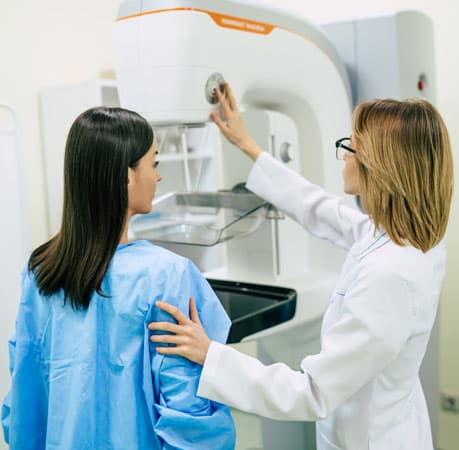Breast Self-Examination the First Step in a Breast Cancer Screening Strategy

Repetition and frequency can be the key to reducing the risk of breast cancer. It will allow you to recognize if something has changed and needs addressing by health care providers. If you have never performed a monthly breast examination before,
your focus on breast health care should start now! You don't want to wait until you notice a problem to get checked out by your doctor. It is essential to know how to perform a breast exam so you will recognize any abnormalities. This way, you'll
catch them earlier rather than later.
The American College of Obstetricians and Gynecologists, and breast cancer experts recommend that women begin performing their own annual breast exams at age
20. The best time to perform a self-breast exam is around 3 to 5 days after your period starts. It should be done at a similar time every month. At this time in your monthly cycle, your breasts are not as tender. Visual breast self-examination can
be done standing with hands placed on your hips while looking in a mirror at the entire breast.
Handy Breast Self-Exam Tips
• Use gentle pressure when examining the nipples.
• Be sure to check under the arms, too.
• Remember that some changes of the female breast may occur during pregnancy.
• Don't forget to look between the breasts.
• Keep track of what you find using a calendar.
• Know your family history.
Annual Screenings to Evaluate the Risk of Breast Cancer

Early detection of breast cancer will make the difference in preventing breast cancer from progressing. Annual screenings and breast imaging tests, such as regular diagnostic mammograms, can make the difference in detecting cancer before any symptoms
appear.
Clinical Breast Examinations - Every woman over 40 years old should receive an initial clinical breast exam annually. CBE, performed by a trained health professional, involves feeling for masses, checking for symmetry, palpating glands,
and assessing skin texture on the breasts of women. Women who have had children should also undergo yearly routine screening starting at 35 years old.
Mammography - A screening mammogram is recommended for all women aged 50 to 74 years old. It is suggested that younger women make a breast imaging appointment to do a baseline, regular mammogram before menopause. A mammogram uses low
doses of radiation to create detailed pictures of both breasts. An annual screening mammogram will help detect early signs of breast cancer. An abnormal mammogram would show hard masses, calcifications, and architectural distortion.
Breast Ultrasound - Ultrasonography uses sound waves instead of X-rays to produce images of internal organs, including the breasts. These images provide information about the size, shape, location, and density of tissues within the breast.
In addition, ultrasound offers an opportunity to examine lymph nodes near the armpit area.
Breast Tomosynthesis - Advanced breast cancer digital imaging tests combine two or more exposures taken through different angles. Combined into one image to diagnose types of breast cancer. This diagnostic testing allows doctors to
see details inside the breast that were previously missed.
Preventative Breast Cancer Care Begins With Healthy Choices
Many potential benefits come from a healthy diet and a healthy lifestyle. Studies have proven that breast health can be improved with preventative care. Healthy choices and a healthy lifestyle can lower the average risk of the development of breast cancer
in American women. The American Institute for Cancer Research recommends:
• Eat fruits and vegetables every day, at least five servings.
• Limiting alcohol intake to no more than 2 drinks per week.
• Avoiding tobacco use.
• Getting enough sleep each night.
• Exercising regularly.
• Maintaining a normal weight.
• Managing stress well.
• Having regular medical exams.


